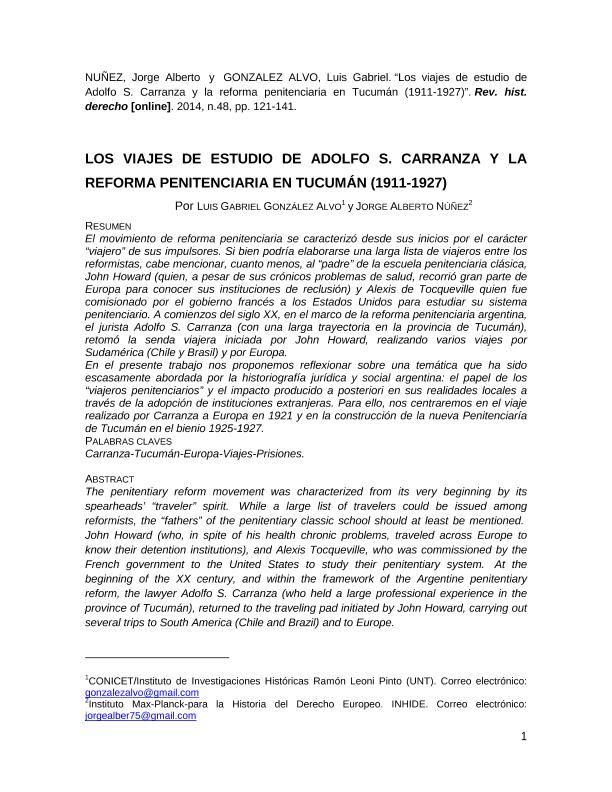Artículo
El movimiento de reforma penitenciaria se caracterizó desde sus inicios por el carácter "viajero" de sus impulsores. Si bien podría elaborarse una larga lista de viajeros entre los reformistas, cabe mencionar, cuanto menos, al "padre" de la escuela penitenciaria clásica, John Howard (quien, a pesar de sus crónicos problemas de salud, recorrió gran parte de Europa para conocer sus instituciones de reclusión) y Alexis de Tocqueville quien fue comisionado por el gobierno francés a los Estados Unidos para estudiar su sistema penitenciario. A comienzos del siglo XX, en el marco de la reforma penitenciaria argentina, el jurista Adolfo S. Carranza (con una larga trayectoria en la provincia de Tucumán), retomó la senda viajera iniciada por John Howard, realizando varios viajes por Sudamérica (Chile y Brasil) y por Europa.
En el presente trabajo nos proponemos reflexionar sobre una temática que ha sido escasamente abordada por la historiografía jurídica y social argentina: el papel de los "viajeros penitenciarios" y el impacto producido a posteriori en sus realidades locales a través de la adopción de instituciones extranjeras. Para ello, nos centraremos en el viaje realizado por Carranza a Europa en 1921 y en la construcción de la nueva Penitenciaría de Tucumán en el bienio 1925-1927. The penitentiary reform movement was characterized from its very beginning by its spearheads' "traveler" spirit. While a large list of travelers could be issued among reformists, the "fathers" of the penitentiary classic school should at least be mentioned. John Howard (who, in spite of his health chronic problems, traveled across Europe to know their detention institutions), and Alexis Tocqueville, who was commissioned by the French government to the United States to study their penitentiary system. At the beginning of the XX century, and within the framework of the Argentine penitentiary reform, the lawyer Adolfo S. Carranza (who held a large professional experience in the province of Tucumán), returned to the traveling pad initiated by John Howard, carrying out several trips to South America (Chile and Brazil) and to Europe. This paper aims to reflect on a subject which has been barely addressed by the argentine legal and social historiography: the role of the "penitentiary travelers" and the evaluation of the impact in their local contexts and realities after the events throughout the adoption of foreign institutions. Therefore we shall focus on the trip carried out to Europe by Carranza in 1921 and the building of the new Penitentiary of Tucumán in the biennium 1925-1927.
Los viajes de estudio de Adolfo S. Carranza y la reforma penitenciaria en Tucumán (1911-1927)
Fecha de publicación:
12/2014
Editorial:
Instituto de Investigaciones de Historia del Derecho
Revista:
Revista de Historia del Derecho
e-ISSN:
1853-1784
Idioma:
Español
Tipo de recurso:
Artículo publicado
Clasificación temática:
Resumen
Palabras clave:
Carranza
,
Tucumán
,
Prisión
,
Viajes
,
Europa
Archivos asociados
Licencia
Identificadores
Colecciones
Articulos(CCT - NOA SUR)
Articulos de CTRO.CIENTIFICO TECNOL.CONICET - NOA SUR
Articulos de CTRO.CIENTIFICO TECNOL.CONICET - NOA SUR
Citación
González Alvo, Luis Gabriel; Nuñez, Jorge Alberto; Los viajes de estudio de Adolfo S. Carranza y la reforma penitenciaria en Tucumán (1911-1927); Instituto de Investigaciones de Historia del Derecho; Revista de Historia del Derecho; 48; 12-2014; 121-141
Compartir




